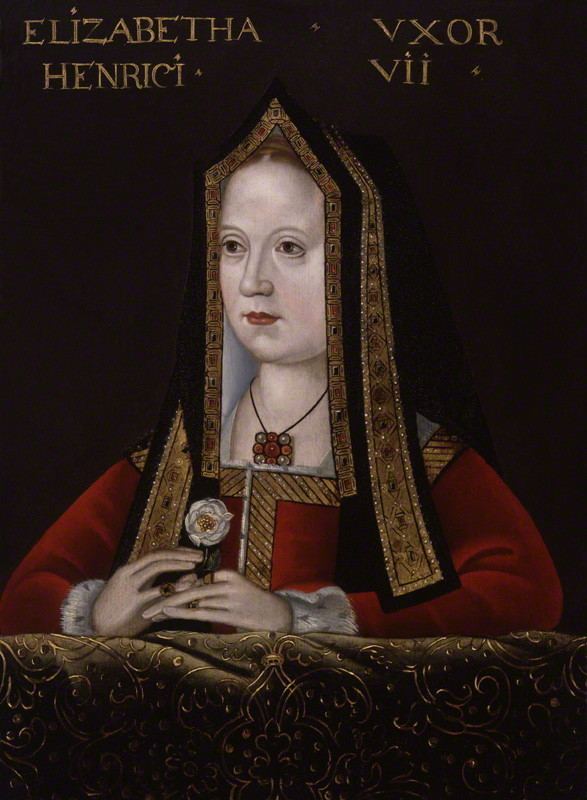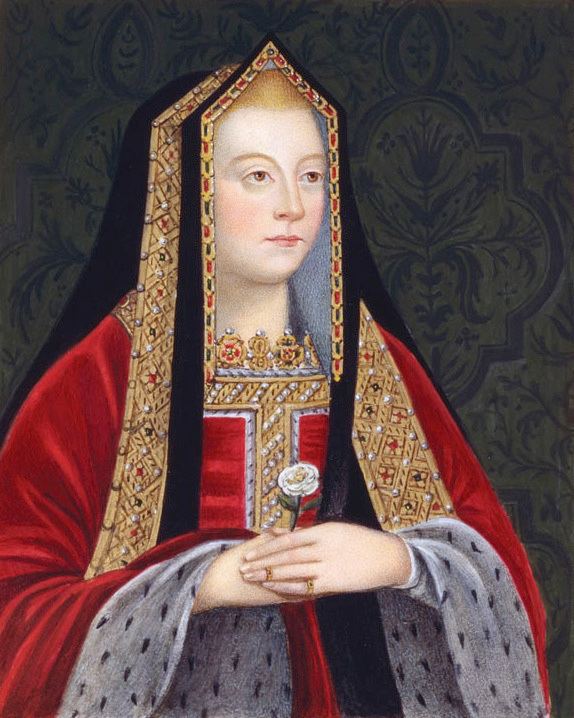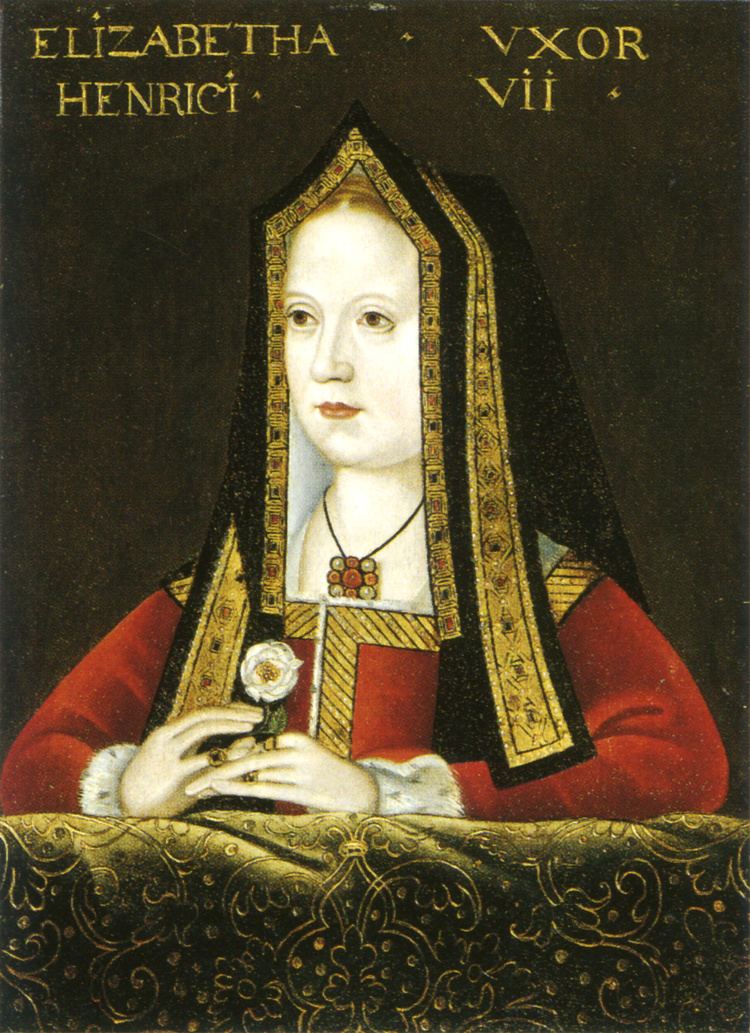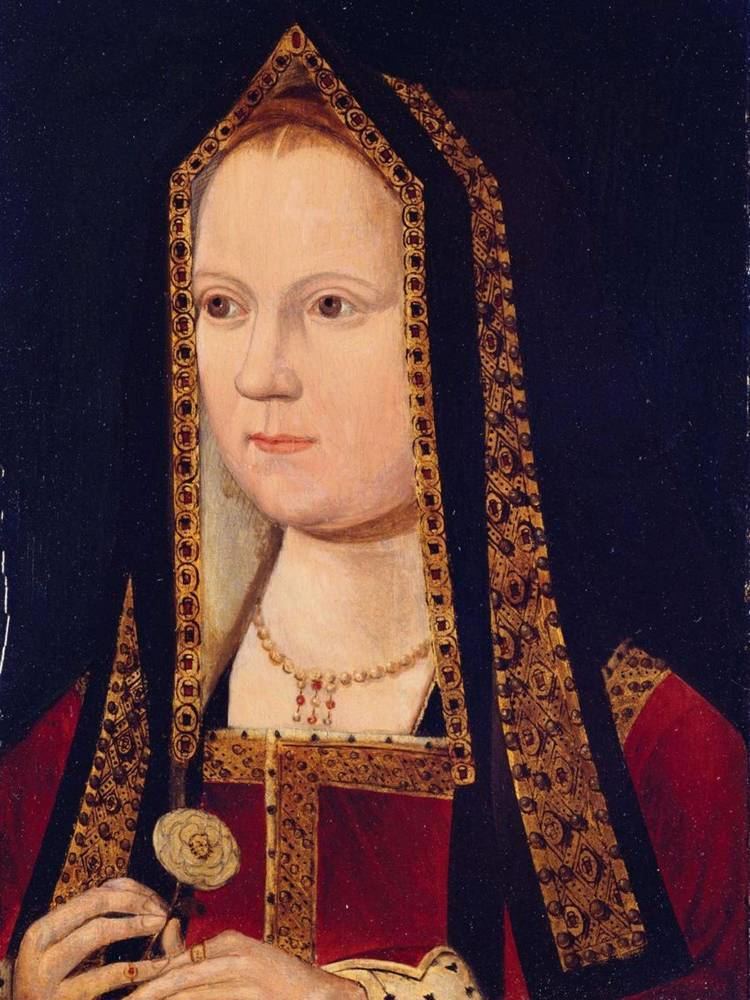Coronation 25 November 1487 House York | ||
 | ||
Tenure 18 January 1486 – 11 February 1503 Born 11 February 1466, Westminster Palace ( 1466-02-11 ) Issue Arthur, Prince of WalesMargaret, Queen of ScotsHenry VIII of EnglandElizabeth TudorMary, Queen of FranceEdmund, Duke of SomersetKatherine Tudor Similar People Henry VII of England, Henry VIII of England, Elizabeth Woodville, Edward IV of England, Arthur - Prince of Wales Died 11 February 1503 (aged 37) Tower of London, London, England | ||
Henry vii elizabeth of york the white queen
Elizabeth of York (11 February 1466 – 11 February 1503) was queen consort of England from 1486 until her death. As the wife of Henry VII, she was the first Tudor queen. She was the daughter of Edward IV and niece of Richard III, and she married the King following Henry's victory at the Battle of Bosworth which started the last phase of the Wars of the Roses. She was the mother of King Henry VIII. Therefore, she was the daughter, sister, niece, wife, mother, and grandmother of successive kings and queens of England.
Contents
- Henry vii elizabeth of york the white queen
- The face of elizabeth of york artistic reconstruction
- Daughter of the king
- Sister of the king
- Niece of the king
- Wife of the king
- Issue
- Legacy
- Elizabeth of York in popular culture
- References

The period of Henry VI's readaption from October 1470 until April 1471 and the period between her father's death in 1483, when she was 17, and the making of peace between her mother and her uncle Richard were violent and anxious interludes in what was mostly a peaceful life. Her two brothers disappeared, the "Princes in the Tower", their fate unknown. She was welcomed back to court by her uncle Richard III, along with all of her sisters. As a Yorkist princess, the final victory of the Lancastrian faction in the War of the Roses may have seemed a further disaster, but Henry Tudor knew the importance of Yorkist support for his invasion and promised to marry her before he arrived in England; this was an important move, which, however, failed to bring him the desired Yorkist support.
Her marriage seems to have been successful, though her eldest son Arthur, Prince of Wales, died at age 15 in 1502, and three other children died young. She seems to have played little part in politics. Her surviving children became a king of England and queens of France and Scotland; it is through the Scottish Stuart dynasty that her many modern royal descendants trace their descent from her.

The face of elizabeth of york artistic reconstruction
Daughter of the king

Elizabeth of York was born at the Palace of Westminster as the eldest child of King Edward IV and his wife Elizabeth Woodville. Her christening was celebrated at Westminster Abbey, sponsored by her grandmothers Jacquetta of Luxembourg, duchess of Bedford, and Cecily Neville, duchess of York. Her third sponsor was her cousin Richard Neville, 16th Earl of Warwick.
At three, she had been briefly betrothed to George Neville in 1469. His father John later supported George's uncle, the Earl of Warwick, in rebellion against King Edward IV, and the betrothal was called off. In 1475, Louis XI agreed to the marriage of 9-year-old Elizabeth of York and his son Charles, the dauphin of France. In 1482, however, Louis XI reneged on his promise. At age 11, she was named a Lady of the Garter in 1477, along with her mother and her paternal aunt Elizabeth of York, Duchess of Suffolk.
Sister of the king
On 9 April 1483, Elizabeth's father unexpectedly died and her younger brother, Edward V, ascended the throne. Her uncle Richard, Duke of Gloucester, was appointed regent and protector of his nephews. Her mother, Elizabeth Woodville, tried to deny Gloucester his right to be Lord Protector and keep power within her family. Gloucester opted to take steps to isolate his nephews from their Woodville relations. He intercepted Edward V while he was travelling from Ludlow, where he had been living as prince of Wales, to London to be crowned king. Edward V was placed in the royal residence of the Tower of London, ostensibly for his protection. Elizabeth Woodville fled with her younger son Richard and her daughters into sanctuary in Westminster Abbey. Gloucester asked to take Richard with him, so the boy could reside in the tower and keep his brother Edward company. Elizabeth Woodville agreed.
Two months later, on 22 June 1483, Edward IV's marriage was declared invalid. It was claimed that Edward IV had at the time of his marriage to Elizabeth Woodville already had been betrothed to Lady Eleanor Butler. Parliament issued a bill, Titulus Regius ("The Title of the King"), in support of this position. This measure legally bastardised the children of Edward IV, made them ineligible for the succession, and declared Gloucester the rightful king, with the right of succession of children of George, 1st Duke of Clarence, another late brother of Gloucester, who had been attainted, already barred before. Gloucester ascended the throne as Richard III on 6 July 1483, and Edward V and his brother are believed to have disappeared shortly afterwards. Rumours began to spread that they had been murdered, largely from English enemies abroad.
Niece of the king
Elizabeth's mother made an alliance with Lady Margaret Beaufort, mother of Henry Tudor, later King Henry VII, who had the closest claim to the throne of those in the Lancastrian party. Although Henry Tudor was descended from King Edward III, his claim to the throne was weak, due to an act of parliament passed during the reign of Richard II in the 1390s, that barred accession to the throne to any heirs of the legitimised offspring of Henry's great-great-grandparents, John of Gaunt and Katherine Swynford. Despite this, his mother and Elizabeth Woodville agreed Henry should move to claim the throne and, once he had taken it, marry Elizabeth of York to unite the two rival houses. In December 1483, in the cathedral in Rennes, Henry Tudor swore an oath promising to marry her and began planning an invasion.
In 1484, Elizabeth of York and her sisters left Westminster Abbey and returned to court when Elizabeth Woodville was reconciled with Richard III, which may suggest that Elizabeth Woodville believed Richard III to be innocent of any possible role in the murder of her two sons (although this is unlikely owing to her involvement in Henry Tudor's failed invasion of October 1483). It was rumoured that Richard III intended to marry Elizabeth of York because his wife, Anne Neville, was dying and they had no surviving children. The Crowland Chronicle claimed that Richard III was forced to deny this unsavoury rumour. There is no conclusive evidence of any relationship between Elizabeth and her uncle, but Sir George Buck (1560-1622) later claimed to have uncovered a letter from Elizabeth indicating that she was involved and willing, although he never produced the supposed letter. Soon after Anne Neville's death, Richard III sent Elizabeth away from court to the castle of Sheriff Hutton and opened negotiations with King John II of Portugal to marry his sister, Joan, Princess of Portugal, and to have Elizabeth marry their cousin, the future King Manuel I of Portugal.
On 7 August 1485, Henry Tudor and his army landed in Wales and began marching inland. On 22 August 1485, Henry Tudor and Richard III fought the Battle of Bosworth Field. Richard III, despite having the larger army, was betrayed by one of his most powerful retainers, William Stanley, and died in battle. Henry Tudor took the crown by right of conquest as Henry VII.
Wife of the king
As the eldest daughter of Edward IV with no surviving brothers, Elizabeth of York had a strong claim to the throne in her own right, but she did not assume the throne as queen regnant. Such a precedent would not truly come to England for another 67 years, when her granddaughter, Mary I, acceded to the throne. Though initially reluctant to keep his promise Henry VII acknowledged the necessity of marrying Elizabeth of York to ensure the stability of his rule and weaken the claims of other surviving members of the House of York, but he ruled in his own right and claimed the throne by right of conquest and not by his marriage to the heir of the House of York. He had no intention of sharing power. He consequently chose to be crowned on 30 October 1485 before his marriage.
Henry VII had the Titulus Regius repealed, thereby legitimising the children of Edward IV, and acknowledged Edward V as his predecessor. After procuring papal dispensation, Cardinal Bourchier, Archbishop of Canterbury, officiated at the wedding of Henry VII and Elizabeth of York on 18 January 1486 in Westminster Abbey. Their first son, Arthur, was born on 20 September 1486. Elizabeth of York was crowned queen on 25 November 1487. Following her Coronation, she gave birth to six more children, but only four survived infancy: Arthur, Margaret, Henry and Mary.
Despite being a political arrangement at first, the marriage proved successful and both partners appear to have grown to love each other. Elizabeth of York did not exercise much political influence as queen due to her strong-minded mother-in-law Lady Margaret Beaufort, but she was reported to be gentle, kind, and generous to her relations, servants, and benefactors. When not at official gatherings, she lived a quiet life largely away from politics with three of her children at Eltham Palace. Elizabeth of York enjoyed music and dancing as well as dicing. She also kept greyhounds.
On 14 November 1501, Elizabeth of York's 15-year-old son Arthur married Catherine of Aragon, daughter of King Ferdinand II of Aragon and Queen Isabella I of Castile. The pair were sent to Ludlow Castle, the traditional residence of the prince of Wales. Arthur died in April 1502. The news of Arthur's death caused Henry VII to break down in grief, as much in fear for his dynasty as in mourning for his son. Elizabeth comforted him, telling him that he was the only child of his mother but had survived to become king, that God had left him with a son and two daughters, and that they were both young enough to have more children.
Elizabeth of York became pregnant once more and spent her confinement period in the Tower of London. On 2 February 1503, she gave birth to Katherine, but the child died a few days afterwards. Succumbing to a post partum infection, Elizabeth of York died on 11 February, her 37th birthday. Her husband and children appear to have mourned her death deeply. According to one account, Henry Tudor "privily departed to a solitary place and would no man should resort unto him." This is notable considering that, shortly after Elizabeth's death, records show he became extremely ill himself and would not allow any except his mother Margaret Beaufort near him. For Henry Tudor to show his emotions, let alone any sign of infirmity, was highly unusual and alarming to members of his court.
In 2012, the Vaux Passional, an illuminated manuscript that was once the property of Henry VII, was rediscovered in the National Library of Wales. It depicts the aftermath of Elizabeth's death vividly. Henry VII is shown receiving the book containing the manuscript in mourning robes with a doleful expression on his face. In the background, behind their father, are the late queen's daughters, Mary and Margaret, in black veils. An 11-year-old King Henry VIII's red head is shown weeping into the sheets of his mother's empty bed.
Henry VII entertained thoughts of remarriage to renew the alliance with Spain — Joanna, Dowager Queen of Naples (niece of Ferdinand II of Aragon), Joanna, Queen of Castile (daughter of Ferdinand and Isabella), and Margaret, Dowager Duchess of Savoy (sister-in-law of Joanna of Castile), were all considered — but he died a widower in 1509.
Annually on her death day, he decreed a requiem mass be sung, the bells be tolled, and 100 candles be lit in her honour; such remembrances were also ordered by other monarchs for their consorts, examples being Richard II for his queen, Anne of Bohemia, and Edward I for his consort Eleanor of Castile.
The Tower of London was abandoned as a royal residence, evidenced by the lack of records of it being used by the royal family or Henry Tudor after 1503. All future births in the reign of Elizabeth's son, Henry VIII, took place in palaces.
Henry VII's reputation for miserliness became worse after the death of Elizabeth of York, as evidenced by the tax collection rolls of the time; however, again, a connection between his avarice and her death is not supported by the evidence. The tax revolts in Yorkshire 1489 and in Cornwall 1497 bear witness to that. It is possible his reputation for miserliness was offset by the lack of the crown's charity work after his wife and queen's death.
He was buried with Elizabeth of York under their effigies in his chapel. Her tomb was opened in the 19th century. The wood casing of her lead coffin was found to have been removed to create space for the interment of her great-great-grandson James VI and I.
Issue
Elizabeth and Henry VII had eight children:
Legacy
According to folklore, the "queen ... in the parlour" in the children's nursery rhyme "Sing a Song of Sixpence" is Elizabeth of York, while her husband is the king counting his money. The symbol of the Tudor dynasty is the Tudor rose, which became a royal symbol for England upon Elizabeth's marriage to Henry VII in 1486. Her White Rose of York is most commonly proper to her husband's Red Rose of Lancaster and today, uncrowned, is still the floral emblem of England.
Elizabeth of York was a renowned beauty, inheriting her parents' fair hair and complexion. All other Tudor monarchs inherited her reddish gold hair and the trait became synonymous with the dynasty.
